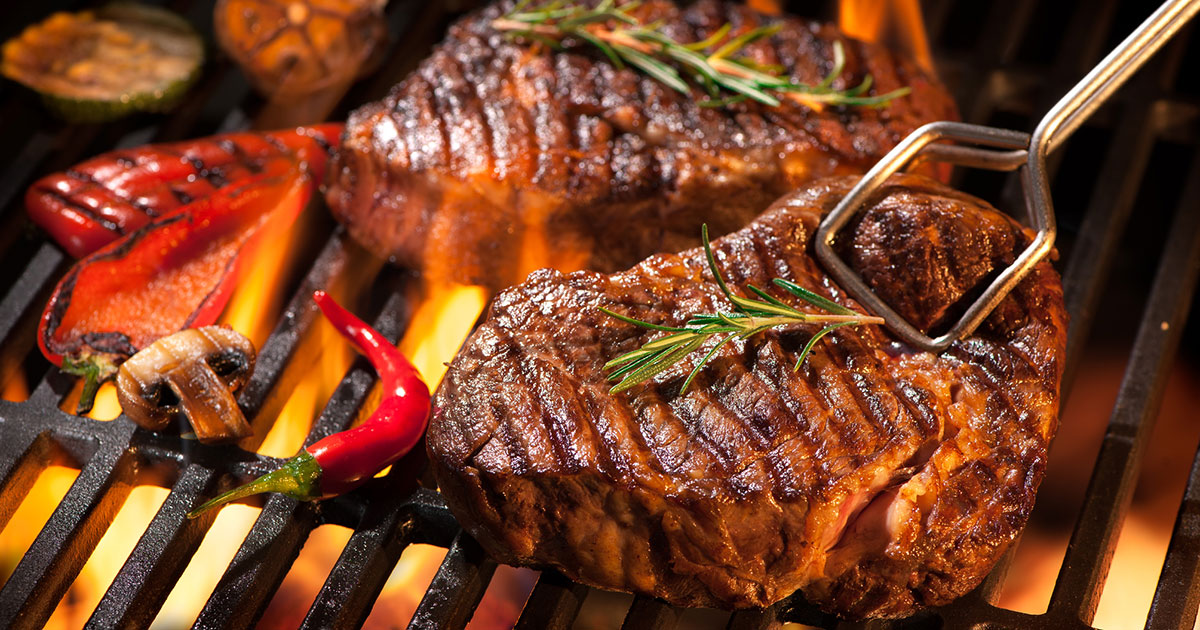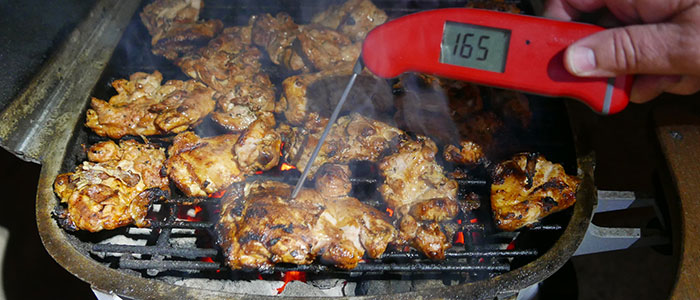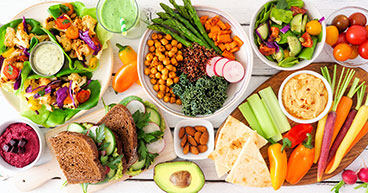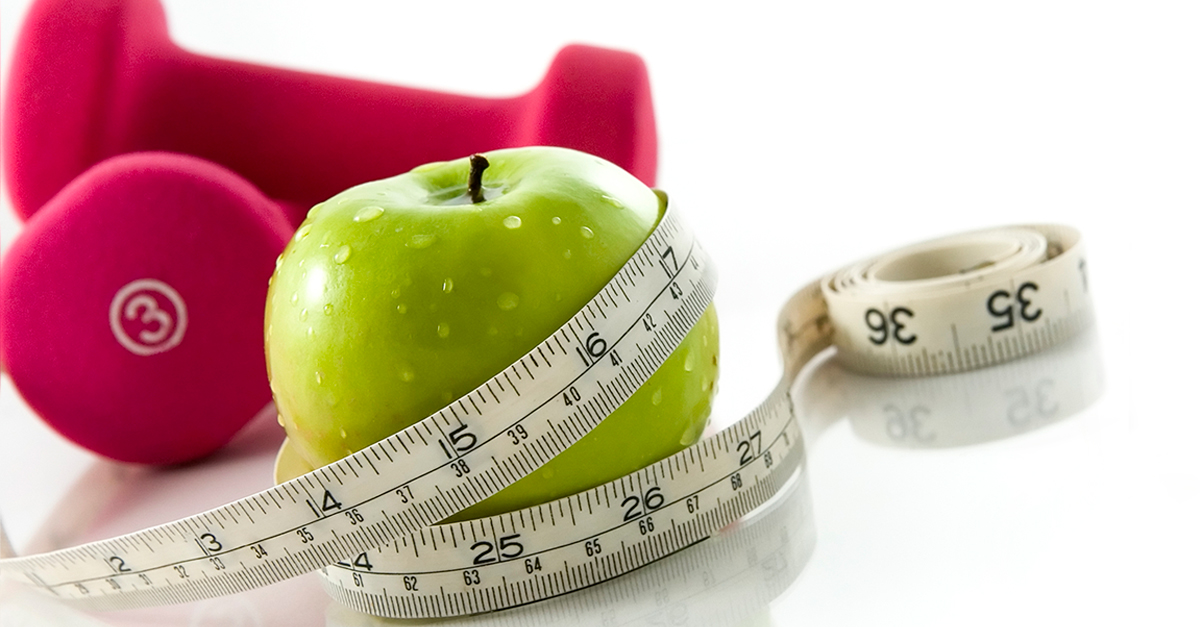
From juicy prime steaks and burgers to saucy grilled chicken and spicy sausage , who doesn’t love the traditional flame-broiled fare of a backyard barbecue? In fact, 80 percent of American homeowners have an outdoor grill and 42 percent use it at least once a week.
Yet, many people don’t know that grilled food may increase your risk for developing some cancers, including colorectal cancer, according to the American Institute for Cancer Research (AICR). Most people, including cancer patients, don’t need to stay away from grilling altogether. Research shows that cancer risk depends on how often you eat grilled fare, the cooking method you use and the types of foods you choose.
“Grilling can occasionally be a healthy cooking method, but you need to be careful,” says Carolyn Lammersfeld, MBA, MS, RD, CSO, LD, Vice President of Integrative Medicine at City of Hope Atlanta, Chicago and Phoenix. So, before hosting your next BBQ, be sure you know the healthy, and unhealthy, ways to fire up the grill and some good-for-you food choices.
In this article, we’ll discuss:
- Are grilled foods safe to eat?
- Which carcinogens are in grilled foods?
- Is a gas grill better than charcoal for cancer risk?
- Tips for grilling healthier food
If you’ve been diagnosed with cancer and are interested in a second opinion on your diagnosis and treatment plan, call us or chat online with a member of our team.
Are grilled foods safe to eat?
Many of the foods we enjoy grilled, including red meat (beef, pork and lamb) and processed meats (hot dogs and sausages), have been tied to an increased risk of colorectal and other cancers. Grilling adds to the risk since the cooking method exposes meat to carcinogens, chemicals or substances known to cause cancer.
“Cooking meat at high temperatures creates carcinogens that may cause changes to DNA that increase the risk of cancer,” says Lammersfeld. “Processed meats have compounds within them that are known carcinogens. Especially in the case of grilling fat from the meat, it may splash, creating flames and smoke, causing carcinogens to splash back onto the food,” she explains.
The healthiest food choices for grilling include leaner meats, such as chicken and seafood, or vegetable or fruit kebabs with tofu. As a general rule, Lammersfeld recommends eating red meat no more than four times a week, and in smaller portions. A portion should be no bigger than the size of a deck of cards or the palm of your hand. Processed meat should only be consumed in moderation.
Which carcinogens are in grilled food?
When grilling, meats are exposed to two types of carcinogens:
- Heterocyclic aromatic amines (HCAs)
- Polycyclic aromatic hydrocarbons (PAHs)
HCAs and PAHs have not been proven to cause cancer in people, but studies have shown they alter DNA in a way that could lead to cancer. Here’s how the two carcinogens form during grilling:
HCAs are produced when proteins inside meat react to intense heat. The longer meat is on the grill the higher the level of HCAs. The burnt edges you see on your steak and the black char that builds up on grill grates are concentrations of HCAs.
PAHs form as fat and juices drip into the fire, causing flames and smoke. Smoke spreads PAHs onto the surface of foods. When you cook on the grill, your lungs are also exposed to PAHs from smoke.
The level of HCAs and PAHs varies by meat type, “doneness” level (rare, medium, or well done) and cooking method. While HCAs still form when grilling fish and seafood, you typically don’t cook these foods as long as meat or chicken, which reduces the accumulation of carcinogens. If you like your steak well done, consider how these three grilling methods may affect the HCAs and PCAs in the meat.
Direct heat grilling is cooking food either above hot coals or above a propane flame. Direct heat exposes food to HCAs from high heat and charring and to PAHs from smoke.
Indirect heat grilling surrounds food with lower temperatures from different angles. Indirect grilling may be done a few different ways: placing foil or a metal pan between food and the heat source, stacking coals on one side of the grill and cooking meat on the other or turning off burners on one side of a gas grill and placing food on the unlit side. Grilling with indirect heat is slow so it exposes meat to high cooking temperatures longer.
Combination grilling calls for searing food quickly on each side over an open flame (direct heat), then switching to indirect grilling by moving foods away from the heat to finish cooking. While this method of grilling is faster than indirect heat, it still exposes foods to high temperatures and smoke.
“There are many healthier alternatives to grilling meats,” says Lammersfeld. “Grilling veggies and fruit do not produce dangerous compounds. Lentils, beans and soy products are also wonderful sources of protein. If you’re not used to these foods, try to incorporate one vegetarian meal into your diet for one week, and increase it from there.”
Is a gas grill better than charcoal for cancer risk?
Gas or electric grills may pose a lower risk of introducing carcinogens in foods than charcoal grills. Charcoal itself is not a carcinogen, but cooking with charcoal has been linked to two types of cancer risks. First, charcoal grills tend to cook at very high temperatures. Kettle drum-style charcoal grills may reach temperatures between 600-700 F. By comparison, gas and electric grills have temperature controls, so it’s easier to cook at lower temperatures. Between 375-450 F is considered medium-high heat.
Second, charcoal cooking creates a lot of smoke, which is known to carry carcinogens. Lammersfeld recommends using a gas grill over charcoal. But if you choose to use charcoal, use leaner meats that may drip less fat on the coals.

Tips for grilling healthier meals
Grilling is a lifestyle choice, and you can take steps to reduce cancer risk for yourself and your family. Here are seven tips to help you plan and enjoy healthy outdoor cookouts:
Cook smaller pieces: Small portions of meat cook more quickly so they have less exposure to high cooking temperatures, reducing carcinogens.
Try pre-cooking: When grilling larger cuts of meat, reduce the time it’s exposed to high heat by partially cooking in a microwave, oven or stove. Just 90 seconds in the microwave is enough to reduce the amount of juices and help prevent flare ups. Also, always thaw meat before grilling.
Keep heat low: Or better yet, use indirect grilling by cooking in the center of the grill with charcoal or flames on the sides. Other ways to reduce heat include cooking meats on top of foil, or in a foil package, or raising the cooking surface as far away from the heat as possible.
Flip frequently. Fewer HCAs form when you turn meat over frequently. So don’t just put meat on the grill and let it sit several minutes before flipping. Also, avoid flattening burgers, releasing fat that may flare up, and, instead, flip them more frequently.
Use marinades: Studies suggest that marinating meat, poultry and seafood for at least 30 minutes before grilling may create a barrier that decreases the level of HCAs. Use a mixture that includes vinegar and lemon juice along with oil, herbs and spices.
Choose leaner meats: Chicken, seafood, skinless turkey and lean cuts of beef, lamb or pork, have less fat, which reduces flames and smoke. Also, trim the fat from meat before grilling and cut off burnt edges (where HCAs are concentrated) before serving.
Mix up your menu: Grilling vegetables and fruits produces no HCAs. They also contain fiber, vitamins and naturally occurring compounds called phytochemicals believed to have cancer-prevention benefits. Try onions, zucchini, portobello mushrooms, eggplant, bell peppers or tomatoes in thick slices on the grill, in a grill basket or in kebabs. Grilled peaches, pears and pineapple make a healthy and tasty side dish or dessert for your backyard barbecues.
If you’ve been diagnosed with cancer and are interested in a second opinion on your diagnosis and treatment plan, call us or chat online with a member of our team.


